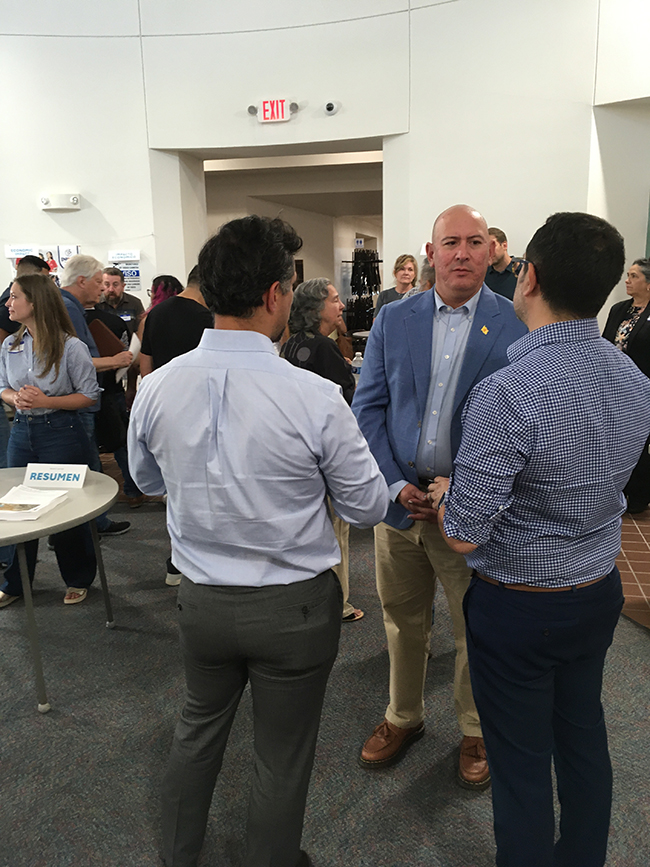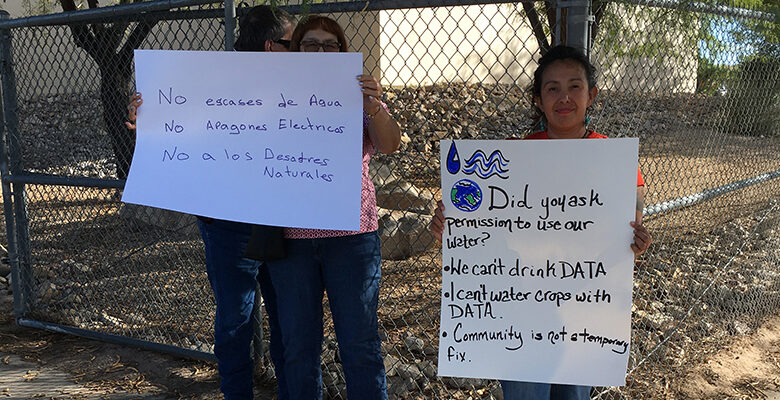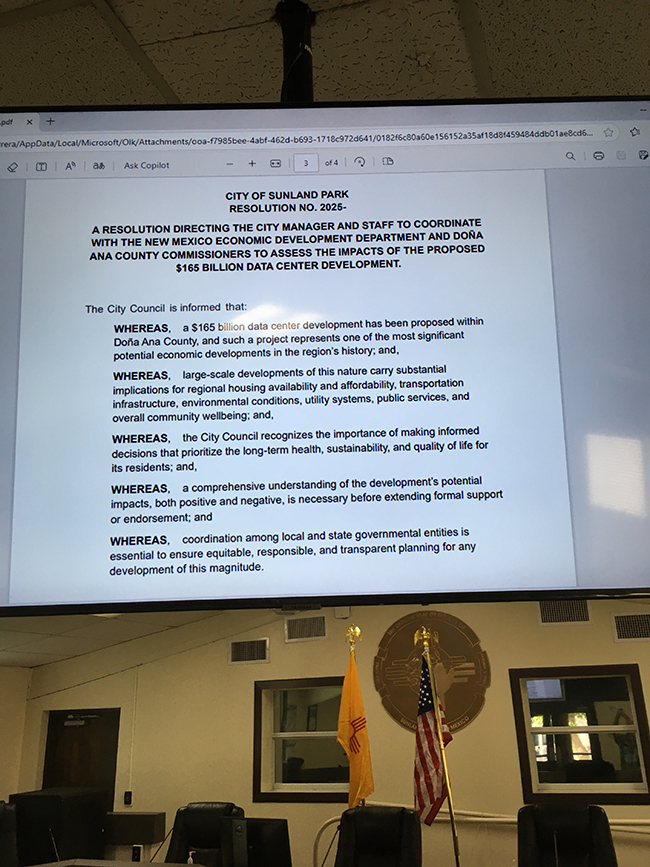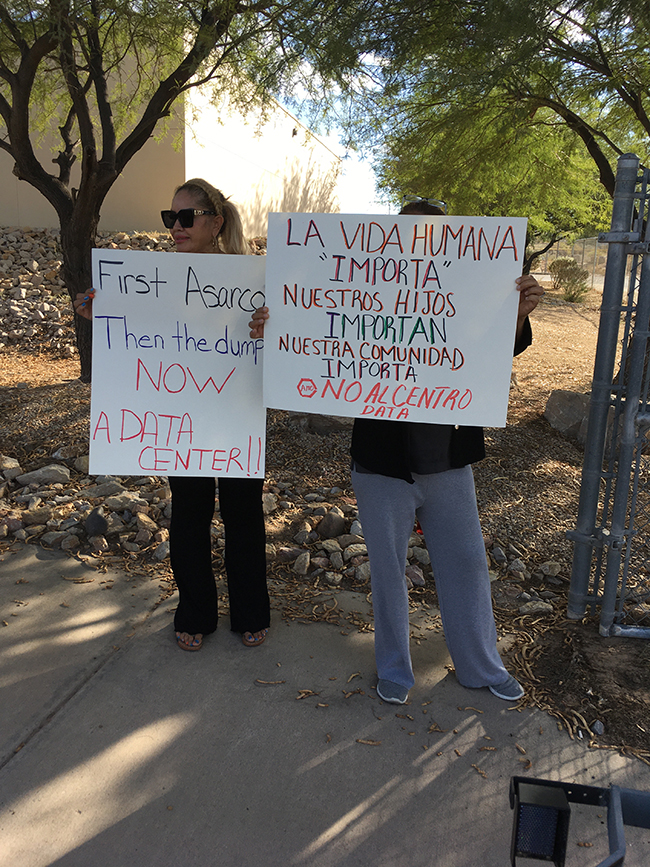By Kent Paterson
September 19 looms as a fateful day in Doña Ana County, New Mexico. That’s when the Doña Ana County Commission will meet in the county seat of Las Cruces, hold a public hearing and vote on whether to advance an ordinance for a property tax-exempting Industrial Revenue Bond that could usher in Project Jupiter in Santa Teresa, the proposed $165 billion economic development project of Artificial Intelligence utilizing data centers and more.
For proponents of the plan steered by Austin-based BorderPlex Digital Assets (BDA) and partnering companies, Project Jupiter will mark a stellar flight to a starry future not only for Doña Ana County but also the Paso del Norte borderland and New Mexico in general. For opponents, the development resembles something more like a flimsy pile of costly and possibly toxic cards teetering atop shifting quicksand.
Leading up to September 19, several well attended-and sometimes even standing room- public meetings sponsored by Project Jupiter were held up and down the vast southern New Mexico county that extends north from the Mexican border to the Hatch Valley Indeed, it’s hard to recall the last time a “local” issue stirred such an outpouring of public interest in Doña Ana County.
For starters, many might still wonder what is Project Jupiter and who is behind it. Essentially a private-public consortium, Project Jupiter includes spearheading BorderPlex Digital Assets, international builder Stack Infrastructure, water development partner EPCOR (parent company is the City of Edmonton, Canada), El Paso Electric and the international telecommunications company Fl? Networks.
From the public sector, among others Project Jupiter’s bandwagon features the administration of New Mexico Governor Michelle Lujan Grishmam, who signed a Memorandum of Understanding last February with BDA pledging generous state economic and logistical support; New Mexico State University and Doña Ana Community College, key New Mexico state lawmakers and officials from Doña Ana County government.
Stressed Water, Secret Info and the CRRUA Divorce
Not surprisingly, the proposed Santa Teresa megaproject came up at the September 8 meeting of the publicly owned Camino Real Regional Utility Authority (CRRUA) the water and wastewater utility that services the southern county communities of Sunland Park and Santa Teresa bordering Mexico.
A Non-Disclosure Agreement (NDA) that proposed builder Stack sent to CRRUA prompted some discussion between board members and attorney Adan Trujillo. Board member Mark Rodriguez asked what is “the driving force” behind the request. Trujillo said there were no likely, specific confidential issues disclosed by the requestor, but that as the project develops certain information concerning sub-tenants might want to be kept confidential.
Trujillo said Stack was informed that as a public agency CRRUA is subject to the New Mexico Inspection of Public Records Act which allows citizens and journalists to access important government information. Barring a statutory exception, anything Stack (or other Project Jupiter components) submit to CRRUA is a public document, Trujillo said. “We’re going to have to follow state law,” he said. “(Stack) understood that.”
Project Jupiter has rolled onto the local scene at a time when CRRUA, embroiled in multiple cases of litigation, is undergoing a break-up by its two parents, the City of Sunland Park and Doña Ana County government.
Sunland Park and Doña Ana County officials have confirmed that Sunland Park will assume CRRUA service within the city’s jurisdiction while the county government will take over responsibility for the Santa Teresa industrial zone near the proposed Project Jupiter site. What won’t change is that post-CRRUA utilities will draw water from the same stressed aquifer, unless it’s imported from elsewhere.
Moving ahead at the September 8 meeting, the CRRUA Board approved the adoption of the City of Sunland Park human resources policy.
Still, the “divorce” agreement is at its preliminary stages, as assets and water rights are up for negotiation. Per the last Joint Powers Agreement between the City and County, the two parties have a little less than four years to completely dissolve CRRUA, but officials from both sides want the job finished much sooner, though no specific dates are yet outlined.
“We want to get some timeline in place,” CRRUA Board Chair and Sunland Park Mayor Javier Perea told the reporter at the September meeting.

As it stands, CRRUA is increasingly challenged to deliver services due to the pace of existing developments and increased strain on groundwater resources, both from residential and commercial uses, as well as the cost of ensuring adequate infrastructure is in place.
For instance, CRRUA contractor Eric Lopez of Bridel Services reported that two solar farms and the Trump administration’s border wall expansion are using CRRUA water to the tune of 350-375 gallons per minute and 250 gallons per minute, respectively, adding “an enormous amount of usage based on construction.”
In terms of wastewater treatment, CRRUA’s North Wastewater Treatment Plant is nearing capacity at 800,000 gallons per day and forcing some of the flow to be transferred to the Sunland Park Wastewater Treatment plant. On this score, CRRUA board members approved a public-private partnership to construct an expanded North Wastewater Treatment Plant “cell” capable of handling upwards of an additional one million gallons per day.
As presented by contractor Robert Garza and Associates, the estimated overall price tag of the project was valued at $10 million, with two private developers splitting most of the costs.
CRRUA Executive Director J.C. Crosby noted that since CRRUA will no longer exist when the new cell is finished, service will then reside with the City of Sunland Park.
Accompanied by the grassroots Empowerment Congress of Doña Ana County, several local women attended the meeting, later telling the reporter they wanted action on the public health front. Numerous people in their community had died or were ill from suspected environmentally caused diseases, including dementia, Alzheimer’s disease, cancers, kidney disorders and diabetes, they said.
The Resolution and Six Minute Meeting
On the morning of September 9, Project Jupiter was the occasion for a special session of the Sunland Park City Council that lasted six minutes. Meeting virtually, all six councilors approved a resolution directing the City Manager and staff to coordinate with the New Mexico Economic Development Department and the Dona Ana County Commission to assess impacts of the proposed $165 billion Data Center Development.
The resolution stated in part: “…large scale developments of this nature carry substantial implications for regional housing availability and affordability, transportation infrastructure, environmental conditions, utility systems, public services and overall community well being…a comprehensive understanding of impacts, both positive and negative, is necessary before extending formal support or endorsement…”
It’s unclear how such a comprehensive analysis could be completed prior to September 19.
Besides the Sunland Park City Clerk, only a handful of people were physically present for the rapid fire City Council vote, including yours truly, a representative of BDA and Maria Chaparro. Residing in La Union, a neighboring community which has grappled with flooding as well as water supply and wastewater treatment issues, Chaparro draws her water from wells like other residents.
Apart from possible water impacts, Chaparro said she was interested in finding out if Project Jupiter contained economic benefits to the area, especially for youth who are inclined to leave for job opportunities elsewhere. Echoing a common sentiment among southerners, she said southern New Mexico was long neglected by the Land of Enchantment’s powers-that-be.
“Thank god for El Paso, where we are one region, La Frontera, and we watch each other’s backs, take care of each other,” Chaparro said in an interview.
Nonetheless, La Union is New Mexico and residents must see “how this is going to impact us once again, positive or negative..,” she added.
Chaparro then attended a Project Jupiter sponsored meeting in Sunland Park later in the afternoon.
On September 9, well over 100 people jammed the small auditorium of the Doña Ana Community College Branch campus in Sunland Park for the Project Jupiter event. The event was the third of five such meetings held in different parts of Doña Ana County between September 5 and 10.
Outside, picketers from the grassroots Empowerment Congress of Doña Ana County hoisted signs that spelled out their opposition to the project.
Read one placard written in blue and red letters:
“First Asarco, then the dump
Now a Data Center”
For those unfamiliar with the environmental history of Sunland Park, the message referred to the old Asarco smelter once perched above Paisano Drive in next door El Paso (shut down in 1999 and demolished in 2013) that for decades showered lead, arsenic and other toxic emissions on Sunland Park, Ciudad Juárez and El Paso as well as the old medical waste incinerator (shut down in 1992) and adjacent, regional landfill that opened in 1987 and residents likewise vociferously protested-and still do.
(Empowerment Congress organizer Vivian Fuller told me that college security would not allow signs into the auditorium. College security also prohibited backpacks. When I questioned two security officers if the prohibition also applied to media, they relented but only after one officer searched my backpack.)
Two competing handouts were passed out to attendees, one from the Empowerment Congress opposing Project Jupiter and one from Project Jupiter extolling it.
Signaling the enthusiastic backing of southern New Mexico higher education officialdom for Project Jupiter, Doña Ana Community College Chancellor Mónica Torres gave opening remarks before quickly turning over the floor to a surprise speaker who blew in from a New Mexico legislative meeting in Deming: State Senate Majority Whip Michael Padilla.
An elected official who represents Bernalillo County more than 200 miles north of the planned Project Jupiter site, Padilla nonetheless framed the project as having a statewide benefit.
“There are jobs like (Project Jupiter) that will go somewhere around the world. I’d rather them go to New Mexico. These are the jobs of the future,” Padilla insisted. The state senator told the audience that he recently met with New Mexico Governor Lujan Grisham, describing how her social policies like universal free child care, free higher ed tuition and free breakfast and lunch for public school students intertwine with economic development initiatives like Project Jupiter that will create a “powerful workforce.”
To sell their initiative to locals, Project Jupiter assembled a panel of several men and a woman consultant from different project streams. Some expounded on their local histories and, in a salute to the embedded military culture of the Las Cruces-El Paso metroplex, the service backgrounds of their employees.
Project Jupiter spokespersons variously declared that water guzzling concerns were way overblown since the Data Center plus complex would employ a “closed loop cooling system” that recirculates 10 million gallons of water loaded up for lifetime usage; provide anywhere between 2,500 and 5,000 construction jobs and 750-800 permanent jobs; utilize an internal energy microgrid fueled by natural gas before transitioning to renewable sources; invest $165 billion dollars over 30 years; and parlay an extra $300 million to Doña Ana County in lieu of property tax exemptions if an Industrial Revenue Bond is approved by the County Commission.
According to project presenters, the project will not use nuclear energy, increase water or electric rates for residents, meet New Mexico Zero Carbon Energy goals by 2045, and undergo scrutiny by state and local officials for local hiring commitments.
But as the meeting progressed and criticism from the audience mounted, panel members grew stone-faced. Here’s a few audience comments, some of which were followed by thunderous applause:
“I’m a resident. Why don’t I get a tax exemption?”
“This is going to be a toxic waste bomb in the environment.”
“You are offering jobs. At what cost?
“Clean Water! It’s not fair for a disabled child to carry a gallon of water to drink water.”
“Forget (workforce) internships. It’s water!”
For their part, Project Jupiter spokespersons explained the astronomical dollar figures and hefty tax exemptions bandied about their plan are connected to the acquisition of increasingly expensive high tech equipment and the intense scramble and interstate competition for AI market positioning.
“It’s the chips race, it’s about AI,” said one. In reference to the tax-incentive giving competition for new data centers underway between U.S. states, BDA Consultant Jennifer Bradfute declared that if Project Jupiter didn’t get breaks in New Mexico it would look elsewhere for a home base.
Of course, until at least September 19, Project Jupiter remains a grand plan, and one in which it’s not even publicly known if an anchor tenant for the envisioned Santa Teresa mega campus has signed on or who it is.
Miguel Fernandez, CEO of Fl? Networks, said “this project is not a done deal yet,” adding a lot of “moving parts” were in motion. He estimated 8-10 entities were involved, his own company included. “There is no guarantee that this is going to happen until it happens.”
Interviewed after the meeting ended, Jennifer Bradfute, BDA consultant, was asked to by the reporter to elaborate on the water question:
“The project is very interested in investing in equipment that uses as little water as possible, so we’ve been looking for alternatives to water use throughout this project,”
According to Bradfute, a “wide variety of alternatives” could include municipal wastewater, campus use recycle, “brackish desalination,” and even water from other “sources or states.”
The MOU signed between New Mexico Governor Michelle Lujan Grisham and BDA last February states the willingness of the State of New Mexico to subsidize and/or constitute state funds for a pilot desalination and water project that’s featured in an October 31, 2023 NMSU study, But Bradfute qualified the desalination option, saying BDA is “not committed” to the method pending necessary research with partner company EPCOR, a process which involves drilling test wells, characterizing the brackish aquifer and then looking at desalination. “
According to Bradfute, drawing water from the brackish aquifer would involve drilling through the freshwater aquifer (with casing designed to prevent leakage) down to a depth of between 1,500 and 3,000 feet.
Christine Dobbin, who works with the health professional-organized group Healthy Climate New Mexico, spoke out at the meeting about pecan trees succumbing to the regional drought and farmworkers dying in 105-degree heat.
Unconvinced that the closed loop water usage system was a sustainable model in an arid climate, Dobbin expressed other public health and environmental concerns to the reporter.
“And I think energy production is still a big concern. So even if they’re not using a lot of water in their closed system, then using natural gas and polluting a ton of water is still dirtying our water,” she contended. “…any water waste is still water that’s taken from our hands, our crops, our mouths, our children.”
For his part, Doña Ana County Assistant Manager Stephen Lopez said local officials were negotiating with Project Jupiter for “a separate dollar amount” (apart from the $300 million the promoters earlier said they will pay the county government over a 30-year span) payable in the “first couple of years” and dedicated to improving the water infrastructure of Sunland Park and Santa Teresa. According to Lopez, the money will benefit both the City of Sunland Park and Doña Ana County overseen water utilities that emerge from the CRRUA divorce.
Asked to provide a dollar figure on how much extra water money Project Jupiter will provide, Lopez said he couldn’t disclose one because of ongoing negotiations, “but it’s definitely tens of millions and you heard the company acknowledge that tonight.”

Right Before the Vote, Project Jupiter’s $56.9 Million Offering
The amount of extra water money offered by Project Jupiter became clearer on September 15, four days before the scheduled key Dona Ana County Commission vote, when Stack Americas and BDA announced that they will fork out $50 million for water and wastewater improvements across the county, including $10 million set aside for Sunland Park to fund “a metrics-driven grant program aimed at improving water quality in the community, a need that residents emphasized during recent community engagement meetings.”
Stack and BDA also pledged another $6.9 million in “community investment funds” dedicated toward local workforce development, constructing of a career and technical ed facility, building a new Boys & Girls Club facility, water desalination, a Doña Ana County Community College Regional Connectivity Contribution, and “other established community priorities.”
The two Jupiter Project companies stated that “after productive discussions with county leaders,” the payment-in-lieu of taxes meant to offset somewhat the sought-for property tax exemption was now set at $360 million instead of the $300 million originally promised, “through legally binding commitments to Doña Ana County.” That’s if Project Jupiter itself gets built.
“Project Jupiter remains under active site selection and is contingent on the approval of key incentives and permits,” a press release stated. “If approved, the project would move forward as one of the most significant private infrastructure and job-creation investments in the history of Doña Ana County.”
The September 15 press release included positive quotes about Project Jupiter from Doña Ana County Manager Scott Andrews, State Representative Nathan Small (D-Las Cruces), Brian Condit of the New Mexico Building and Construction Trades Council, and New Mexico Environment Department Secretary James Kenney, among others.
Reached earlier in the day by phone, Empowerment Congress of Doña Ana County Director Daisy Maldonado, who attended nearly all of September’s Project Jupiter meetings, assessed strong public opposition as well as lingering questions over differing job numbers, water consumption projections and expenditure promises made by Project Jupiter spokespersons like funneling support for county schools. “The County doesn’t fund schools. I’m curious how that was in the agreement,” Maldonado said.
Far from viewing the upcoming September 19 vote as a done deal, Maldonado added that “there’s plenty of folks who’ve been speaking out and I hope the (County Commissioners) listen to their constituents.” Like many other concerned residents, the Empowerment Congress is mobilizing for the County Commission meeting in Las Cruces.
Regardless of the vote outcome, the Doña Ana County community leader didn’t foresee the big money promoters of Project Jupiter going away, even without direct County support, adding that the Empowerment Congress will stay active around matters like permits and impact assessments related to the development. “We will continue to fight every step of the way,” Maldonado vowed.
The Doña Ana County Commission regular meeting where the vote on advancing Project Jupiter will take place starts at 9 am on Friday, September 19. The meeting will be at the Doña Ana County Commission Chambers located in the Doña Ana County Government Center at 845 N. Motel Blvd. in Las Cruces, New Mexico. The meeting will also be livestreamed on YouTube or through this link: https://www.donaana.gov/government/board_of_county_commissioners/watch_public_meetings/index.php



